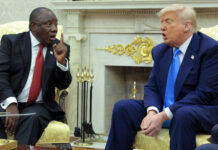
[miningmx.com] — THE world’s major gold producers seek to draw an
iron curtain between their mines and especially Africa’s enormous, varied informal
gold industry.
Growing concerns about “conflict minerals’, including “conflict gold’, could result in
all gold from Africa being branded “blood gold’, as happened with diamonds in Sierra
Leone, according to the formal sector’s marketing council.
The World Gold Council (WGC) has been working for two-and-a-half years on its
conflict-free gold standard, an echo of the Kimberley process whereby the diamond
industry protected itself against reaction to the so-called blood diamonds from West
Africa. The WGC is the market development agency of 23 of the largest gold groups.
Its job is to encourage the demand for gold, and, in this case, to protect it.
The gold standard amounts to certifying that all the gold a mine delivers to a
refinery is indeed its own, and that nothing got lost along the way. When the gold is
at the refinery, the refinery’s own certification through the London Bullion Market
Association comes into effect, says Terry Heymann, the WGC’s Director for
Responsible Gold.
The point is to convince the world’s governments, activists and investors that formal
gold mines in Africa have nothing to do with the funding of violence. The trick is to
make this assurance auditable with standardised requirements.
Activism against conflict resources is increasing in rich countries, and the most far-
reaching intervention is the US’s Dodd-Frank Act of 2010. This Act specifically
targets the Democratic Republic of the Congo (DRC) and, because of smuggling, also
its neighbouring states as sources of “conflict minerals’ – tin, tantalum, tungsten
and gold from which armed groups obtain funding.
The isolation takes place precisely at the point where large new gold investments in
the region are becoming established. “The worst case of all would be if Africa’s gold
is tarred as blood gold,’ says Sven Lunsche, a spokesman for Gold Fields. The
company and AngloGold Ashanti are the two South African members of the WGC.
The WGC started working on its own standard early in 2010, before Dodd-Frank, but
there are now clear ties between the two, Heymann says. The final rules for the
compliance of Section 1502 of Dodd-Frank have been promised for the end of
August, after they were initially supposed to be issued in April 2011.
The WGC has asked the Securities Exchange Commission to exempt consumers of
very small quantities of gold from the requirement of checking the origin of the gold.
Gold used for humanitarian purposes, such as in medical treatment, should also be
exempted, the WGC says.
In addition, it has asked for Tanzania, where among others AngloGold Ashanti
mines, not to be regarded as a “DRC-related country’ and that “responsible formal
mines’ everywhere in Africa should be treated the same as mines in the US.
The gold standard will presumably be accepted soon after the final Dodd-Frank rules
are announced and will be put into effect by external auditors at the beginning of
next year. In 2014, gold companies’ annual reports will start including gold-standard
audits. The standard is worldwide, but the point is to declare the gold from mines
near conflict areas, like parts of the DRC, conflict free.
“When we say “conflict’, we are talking about armed conflict, civil war, guerrilla
fighters,’ Heymann says.
– Sake24









